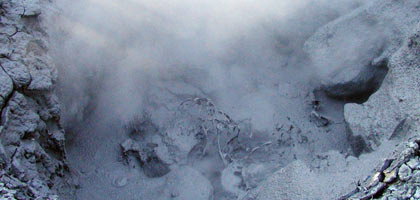

| the expedition | |
| the science | |
| marianas history | |
| daily journal | |
| the team | |
| questions & answers | |
|
the islands Saipan Anatahan Sarigan Guguan Alamagan Pagan Agrigan Asuncion Maug Uracas |
|
|||||||||||||||||||||||||||||||||||||||||||||||||||||||||||||||
Data Interpretation

1) How much water, carbon dioxide, nitrogen, and other gases are released from the entire Marianas arc?
2) What are the ultimate sources of these gases - mantle, subducted sediments, subducted oceanic crust or the atmosphere?
3) How does the output of volatiles to the atmosphere compare to the input into the subduction zone by subducted sediments and oceanic crust?
In the following ways we can begin to answer the above questions:
1) We can measure the sulfur dioxide emissions from the volcanoes using our miniDOAS instrument. From the gas samples that we collected we will
be able to calculate the emissions of all the other gas species.
2) We will use the isotopic composition of carbon in carbon dioxide and nitrogen to determine the sources of these gases. Each reservoir - mantle,
sediments, and oceanic crust - has a distinct isotopic composition. Nitrogen in particular is a very good tracer gas for subudcted sediments
that are rich in organic matter. This organic matter has a very distinct nitrogen isotopic composition compared to the Earth's mantle. Using the
combination of nitrogen carbon and helium isotopes and abundances we will be able to calculate the relative contributions of the mantle, subducted
organic sediments and the subducted oceanic crust to the magmas and to the gases that are emitted to the atmosphere.
3) Once we have resolved the contributions and emission rates of the gases from each reservoir, we can compare those results with the input into the
subduction zone. In the case of Nitrogen, for example, if there is more sedimentary nitrogen subducted than what we measure for the output, then some
of this nitrogen may get introduced into the deeper mantle were it contributed to the chemical composition of the mantle.
If our expedition, sample collection and analyses are successful we will be able to address questions that are of fundamental importance to the chemical evolution of the Earth's mantle, the atmosphere and the oceans. The study of the Marianas arc is complementary to our previous work in Central America where we have addressed similar questions. We hope that by investigating the Marianas arc, our findings will have global significance.
